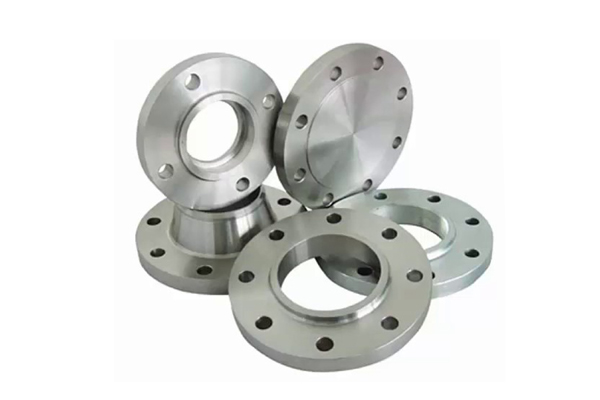With years of experience in this domain, we are offering a qualitative range of M.S. Flanges. These flanges are widely appreciated by our clients for their remarkable quality, guaranteed by us. Our offered flanges are broadly applicable in chemical, processing plants, oil & gas and petrochemical industries. Features like durability and corrosion resistance rank these flanges ahead of their competitors. We offer the entire range in various sizes and dimensions so as to meet clients’ different requirements
FORGED Flanges
With firm commitment to quality, we are involved in manufacturing a flawless range of Forged Flanges. The offered forged flanges is known for its longer service life, to ensure the same, we manufacture these using optimum quality steel and other raw material, sourced from vendors of high repute.

Stainless Steel Flanges
By keeping track of current market development, we are offering a commendable range of S.S. Flanges. Our offered flanges are known for their sturdiness, remarkable quality and cost-effectiveness. These flanges find extended applications in processing plants, chemical and many other industries. The offered range of flanges is manufactured using quality assured metal and modern machines as per the industry defined guidelines.
Making The Connection : Flange Facing Types
Flange design is only the start when considering the ideal flange for your piping system. Face types are another characteristic that will have a major impact on the final performance and service life of your flanges.
Facing types determine both the gaskets needed to install the flange and characteristics related to the seal created.
Common face types include:
- Flat Face (FF) : As the name suggests, flat face flanges feature a flat, even surface combined with a full-face gasket that contacts most of the flange surface.
- Raised Face (RF) : These flanges feature a small raised section around the bore with an inside bore circle gasket.
- Ring Joint Face (RTJ) : Used in high-pressure and high-temperature processes, this face type features a groove in which a metal gasket sits to maintain the seal.
- Tongue and Groove (T&G) : These flanges feature matching grooves and raised sections. This aids in installation as the design helps the flanges to self-align and provides a reservoir for gasket adhesive.
- Male & Female (M&F) : Similar to tongue and groove flanges, these flanges use a matching pair of grooves and raised sections to secure the gasket. However, unlike tongue and groove flanges, these retain the gasket on the female face, providing more accurate placement and increased gasket material options.
Many face types also offer one of two finishes: serrated or smooth.
Choosing between the options is important as they will determine the optimal gasket for a reliable seal.
In general, smooth faces work best with metallic gaskets while serrated faces help to create stronger seals with soft material gaskets.
The Proper Fit : A Look At Flange Dimensions
Apart from the functional design of a flange, flange dimensions are the most likely factor to impact flange choices when designing, maintaining, or updating a piping system.
However, you must consider how the flange interfaces with the pipe and the gaskets in use to ensure proper sizing.
Common considerations include:
- Outside diameter : The distance between two opposing edges of the flange face
- Thickness : A measure of the thickness of the outer attaching rim
- Bolt circle diameter: The distance between opposing bolt holes when measured from centre to centre
- Pipe size : A designation of the pipe size with which the flange corresponds
- Nominal bore size : A measurement of the flange connectors inner diameter
Flange Classification & Service Ratings
Each of the above characteristics will have an influence on how the flange performs across a range of processes and environments.
So how can you tell which flanges are up to the task and which are not?
Flanges are often classified based on their ability to withstand temperatures and pressures.
This is designated using a number and either the “#”, “lb”, or “class” suffix. These suffixes are interchangeable but will differ based on the region or vendor.
Common Classifications include:
- 150#
- 300#
- 600#
- 900#
- 1500#
- 2500#
Exact pressure and temperature tolerances will vary by materials used, flange design, and flange size. The only constant is that in all cases, pressure ratings decrease as temperatures rise.
Flange Standards And Markings
To help make comparison easier, flanges fall under global standards established by the American Society of Mechanical Engineers (ASME) — ASME B16.5 & B16.47.
If you’re attempting to replace or verify existing parts, all flanges must include markers — typically on their outer perimeter — to aid in the process.
These markers also follow a strict order:
- Manufacturer logo or code
- ASTM material code
- Material Grade
- Service rating (Pressure-temperature Class)
- Size
- Thickness (Schedule)
- Heat Number
- Special designations, if any — for example, QT for Quenched and tempered or W for repair by welding
This guide offers a solid foundation of the basics of flange design and how to choose the ideal flange for your piping system. However, with a wide range of stainless-steel flanges and other flange materials available, it is impossible to list every configuration, detail, or consideration.
Should you have questions, the Technical Sales Experts at PRESSURE VALVES are ready to help. Serving industries and businesses across IN INDIA for more than 05 years, we understand the complexities of alloy piping and the needs of your industry.





